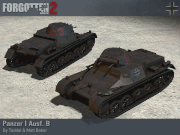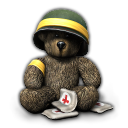 |
||
|
|
||
 |
||
|
ARCHIVES >>> 7/2023
The First of its Kind by: Eat Uranium 30.07.2023 18:00 GMT
Hello and welcome back to another Forgotten Hope 2 update. Today we are showing off the first major revision to the first major combat tank designed and built by Germany that saw combat in WW2. In the aftermath of the First World War, the much reduced German army was forced to re-evaluate its tactics and strategies. One of the main learnings was that the army of the future would need to be mobile, and tanks would play a large role in this aim. The Versailles Treaty had placed a ban on the production and use of tanks by Germany, which meant that testing ideas for how to conduct armoured warfare had to be conducted first with dummy tanks, and then later in secret inside the Soviet Union. With the take over of the Nazi Party, the Versailles Treaty was to be effectively ignored and tank development could increase in intensity. While the ultimate aim was to re-equip with the tanks that would eventually become the Panzer III and IV, it was eventually agreed that in the shorter term a lighter vehicle was needed. In 1933, designs from 5 manufacturers were evaluated, with Krupp's hull and Daimler Benz's superstructure and turret winning. Redesigned after the evaluation, the series 2 La.S. began to roll of the production lines in 1934. This would later be renamed the Panzer I Ausf.A. With over 1000 examples being produced in 2 years, the shortcomings with the Ausf.A design rapidly became apparent. The 60hp Krupp air cooled engine was underpowered and prone to overheating. This was to be solved in the Ausf.B with the 100hp water cooled Maybach NL 38 Tr. To fit the larger engine the hull was lengthened, which allowed a change to the suspension. The idler wheels were moved up off the ground and a 5th road wheel added. The new tank was now more reliable, faster and less likely to break its tracks turning. The Panzer I Ausf.B would serve in Spain, as well as Germany's invasions of Poland, Denmark, Norway, France and the Soviet Union. The survivors were largely removed from active combat by 1942, after which they performed policing duties or had their hulls re-purposed. In total, 399 Ausf.B were constructed with a further 147 hulls mated to Ausf.A turrets. Ours was made by Toddel and Matt Baker. That's all for this week, but be sure to come back next time for another update. Until then, feel free to visit our Discord, our public forums, our Twitter, our subreddit, and/or Facebook pages to discuss this update and other news.
Spam Candle by: Ashton and Eat Uranium 02.07.2023 18:00 GMT
Hello and welcome back to another Forgotten Hope 2 update. Today we are showing off some of the equipemnt that the Norwegians were issued... or not. The Norwegian Army of 1940 was in a sorry state after years of budget cuts and delayed procurement. This was made painfully clear by the hand grenade situation during the German invasion. Despite Norway sometimes being referred to as the birthplace of the modern hand grenade, the Norwegian Army only showed limited interest in this invention. An early design by the pioneering arms inventor Nils Waltersen Aasen had been adopted in 1917 despite its complexity and questionable safety, and the sour experiences with this design lead to production and grenade training being phased out in the 1920's. In 1940 only a few hundred remaining grenades were available to Norwegian forces during the fighting, and they were distributed in minuscule numbers between units. Most units therefore had to improvise or rely on captured hand grenades. Our improvised hand grenade is based on written descriptions from the campaign detailing how tin cans filled with dynamite proved to be an adequate, if somewhat unsafe, substitute for a more standardized model. The Røkboks M/28 smoke candle was adopted in 1928. Like other smoke candles, the M/28 was meant to provide troops with a handy tool for signalling and screening. Its small size made it throwable, giving troops more flexibility in its deployment. A simple design, the smoke filling was activated by striking a friction fuse protected by a removable lid. The M/28 would see service with both military and police forces up until 1940. Both grenades were made by Ashton. Finally today, we have a promotional video for FH2 put together by Slayer. That's all for this week, but be sure to come back next time for another update. Until then, feel free to visit our Discord, our public forums, our Twitter, our subreddit, and/or Facebook pages to discuss this update and other news.
|
|
||||||||||
 |
||||||||||||




























